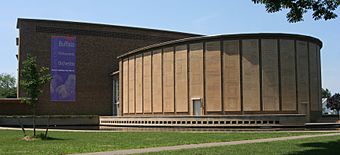Kleinhans Music Hall facts for kids
|
Kleinhans Music Hall
|
|

Kleinhans Music Hall
|
|
| Location | Symphony Circle, Buffalo, New York |
|---|---|
| Area | 4.2 acres (1.7 ha) |
| Built | 1938-40 |
| Architect | Eero Saarinen Eliel Saarinen |
| Architectural style | International Style |
| NRHP reference No. | 89001235 |
Quick facts for kids Significant dates |
|
| Added to NRHP | June 29, 1989 |
| Designated NHL | June 30, 1989 |
Kleinhans Music Hall is a famous concert hall located in Buffalo, New York. It's known for its amazing sound quality and beautiful design. Many people say it's one of the best places to hear music anywhere!
Today, Kleinhans Music Hall is the home of the Buffalo Philharmonic Orchestra. It also hosts the Buffalo Chamber Music Society and many other concerts and local events. The building was designed by a father-and-son team, Eliel Saarinen and Eero Saarinen. They worked with other experts to make sure the building looked great and sounded even better.
Kleinhans Music Hall has two main performance areas. It also has extra rooms for rehearsals or private parties. Because of its special architecture, it was named a National Historic Landmark in 1989. This happened 49 years after it was finished.
Contents
Discovering the Performance Spaces
Kleinhans Music Hall has two main areas where performances take place. These are the main auditorium and the Mary Seaton Room.
The Main Auditorium
The main auditorium at Kleinhans Music Hall is the larger space. It can seat 2,441 people. This room shows off the hall's special curved ceiling and its design, which is all about making sound perfect.
The shape of the hall is very clever. It's designed so that everyone, even those in the very back rows, hears the music clearly. The sound reaches them just as well as it does for people in the front rows. An expert named Charles C. Potwin used a special 1:1.3 ratio when designing the room. This helped create the best possible sound.
The main auditorium's design helps create a close and personal feeling for the audience. The simple colors and clean lines in the room also help. They make sure you focus on the music without any distractions from fancy decorations.
The Mary Seaton Room
The Mary Seaton Room is the smaller of the two performance areas. It can hold up to 700 people for a concert. This room is perfect for smaller music groups, like chamber ensembles.
The Story of Kleinhans Music Hall
Kleinhans Music Hall was named to honor two important women. Edward L. Kleinhans named it after his wife, Mary Seaton Kleinhans, and his mother, Mary Livingston Kleinhans.
The Kleinhans family owned a very successful men's clothing company in Buffalo. This was around the early 1900s. When Edward and his wife passed away in 1934, they left all their money to the Community Foundation of Greater Buffalo. This was about $1 million. They asked for the money to be used to build a music hall.
Building the Hall
The music hall was finished in 1940. The total cost to build it was $1.5 million. This money came from the Kleinhans family's gift. It also came from President Franklin D. Roosevelt's Public Works Administration. This was a government program that helped create jobs during tough economic times.
Kleinhans Music Hall officially opened on October 19, 1940. The very first concert was performed by the Buffalo Philharmonic Orchestra. Maestro Franco Autori led the orchestra that day.
In 2015, the seats in the main auditorium were updated. Also, some storage rooms were changed into an archive room. This room now helps teach people about the building's history and its important design.
Famous Moments at Kleinhans
Many important events have happened at Kleinhans Music Hall over the years.
On September 8, 1964, Robert F. Kennedy gave a speech there. At the time, he was running to become a United States Senator for New York. About 6,000 people came to hear him speak.
On November 9, 1967, Dr. Martin Luther King Jr. also gave a speech at Kleinhans. His speech was called "The Future of Integration." In it, he shared a powerful message. He said, "We are moving toward the day when we will judge a man by his character and ability instead of by the color of his skin."



